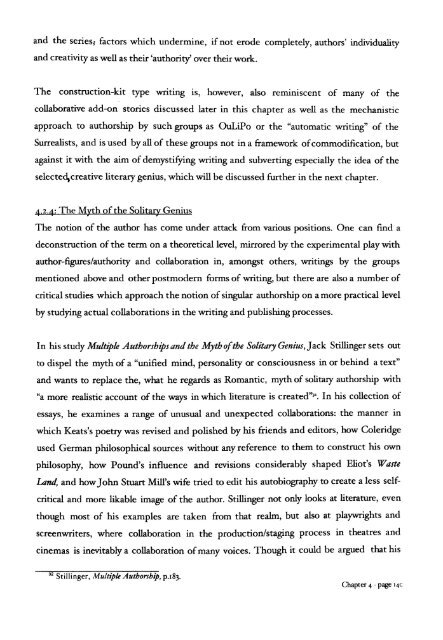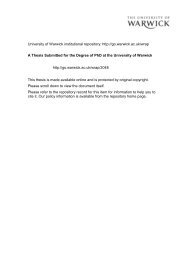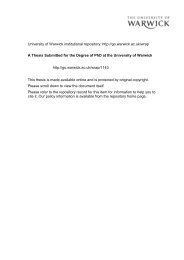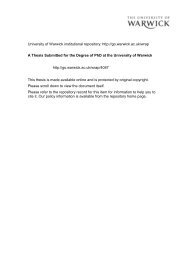From Page to Screen - WRAP: Warwick Research Archive Portal ...
From Page to Screen - WRAP: Warwick Research Archive Portal ...
From Page to Screen - WRAP: Warwick Research Archive Portal ...
Create successful ePaper yourself
Turn your PDF publications into a flip-book with our unique Google optimized e-Paper software.
and the series; fac<strong>to</strong>rs which undermine, ifnot erode completely, authors' individuality<br />
and creativity as well as their 'authority' over their work.<br />
The construction-kit type wntmg IS, however, also reminiscent of many of the<br />
collaborative add-on s<strong>to</strong>ries discussed later in this chapter as well as the mechanistic<br />
approach <strong>to</strong> authorship by such groups as OuLiPo or the "au<strong>to</strong>matic writing" of the<br />
Surrealists, and is used byallof these groups not in a framework ofcommodification, but<br />
against it with the aim ofdemystifying writing and subverting especially the idea of the<br />
selected.creative literary genius, which will be discussed further in the next chapter.<br />
4.2.4: The Myth ofthe Solitary Genius<br />
The notion of the author has come under attack from various positions. One can find a<br />
deconstruction ofthe term on a theoretical level, mirrored by the experimental play with<br />
author-figures/authority and collaboration in, amongst others, writings by the groups<br />
mentioned above and other postmodern forms of writing, but there are also a number of<br />
critical studies which approach the notion ofsingular authorship on a more practical level<br />
by studying actual collaborations in the writing and publishing processes.<br />
In his study Multiple Authorshipsand the Myth ofthe Solitary Genius, Jack Stillinger sets out<br />
<strong>to</strong> dispel the myth of a "unified mind, personality or consciousness in or behind a text"<br />
and wants <strong>to</strong> replace the, what he regards as Romantic, myth of solitaty authorship with<br />
"a more realistic account of the ways in which literature is created">. In his collection of<br />
essays, he examines a range of unusual and unexpected collaborations: the manner in<br />
which Keats's poetry was revised and polished by his friends and edi<strong>to</strong>rs, how Coleridge<br />
used German philosophical sources without any reference <strong>to</strong> them <strong>to</strong> construct his own<br />
philosophy, how Pound's influence and revisions considerably shaped Eliot's Waste<br />
Land, and howJohn Stuart Mill's wife tried <strong>to</strong> edit his au<strong>to</strong>biography <strong>to</strong> create a less self<br />
critical and more likable image of the author. Stillinger not only looks at literature, even<br />
though most of his examples are taken from that realm, but also at playwrights and<br />
screenwriters, where collaboration in the production/staging process in theatres and<br />
cinemas is inevitably a collaboration ofmany voices. Though it could be argued that his<br />
32 Stillinger, Multiple Authorship, P.I83.<br />
Chapter 4 - page 14C





